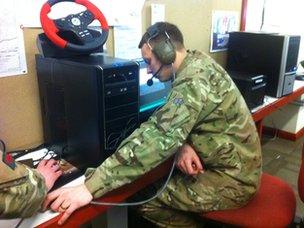British army stages record-breaking virtual battle
- Published

Army commanders are trying to work out what resources their budget should be spent on
The British army has conducted its largest virtual battle simulation, involving 220 soldiers.
The experiment was carried out at the Army's Land Warfare Centre in Warminster, Wiltshire.
The two-hour scenario saw soldiers on computers completing virtual missions in a fictional French town.
The Army says the simulation will help it to find out which resources it needs to invest in, once it takes control of its own budget in April 2013.
"The aim is to understand how various changes have an impact on the speed at which command can respond," said Col Tim Law, assistant head of army force development.
"We're trying to determine exactly what we need to fight and win the wars of tomorrow."
Virtual clutter
By altering variables, like the number of troops on the ground and the amount of surveillance and communication available, the simulation had provided essential data about what was the most useful in a battle situation, Col Law said.
Combining virtual simulations and training exercises on the ground has already indicated ways logistics can be improved.
Each company in Afghanistan was provided with three Intelligence Corps personnel, but there remained uncertainty as to where they were best placed - out in the field or back at base, Col Law said.
"We have already determined in this experiment that it's better for them to be at battlefield HQ, feeding information down the line and planning ahead," he added.
Urban Warrior 5, as the project is called, has cost about £1m to develop and was built with VBS2 software, which is also used commercially by the games industry to create virtual worlds.
Lovelle - the name of the fictional town in the simulation - was a replication of a town in France where the training exercise had been carried out in real life, said Col Law.
"But with virtual we can add 'clutter'," he said. "Like trees and civilians."
There were inevitably comparisons with Activision's Call of Duty series, but Urban Warrior 5 was not a game, said Dr Nigel Paling, science advisor with the UK government's Defence Science and Technology Laboratory.
"We have tailored commercially available software, but we're pushing the edges of realism and scale," he told the BBC.
"In Call of Duty buildings don't 'rubble-ise'. We have recreated actual weapon effects."
Unlike real life however, soldiers in the game are able to regenerate if killed.
"This is not about killing people," said Col Law, "It's about winning the battle."
War games
Lt Col Charlie Barker, chief of staff at Urban Warrior 5C, is unequivocal that Call of Duty would not have been a viable - if more economic - alternative.
"It would be like trying to do 120mph in the fast lane on a bicycle," said Lt Col Barker.
However, Col Law admitted virtual environments had their limits.
"The problem is that all you have is the screen," he said.
"In reality your unit would be shouting, 'Look out, over there,' - situation awareness isn't entirely visual."
Further simulations involving different troops will be run until June 2013, after which all the data will be analysed.
"The Army is seeking to modernise and define its direction in the future," said Col Law - although he admitted this was a challenging task.
"We are noting that current events show how unpredictable this will be," he added. "It's a bit like nailing jelly to the wall."
- Published17 July 2012
- Published8 March 2012
- Published16 February 2011